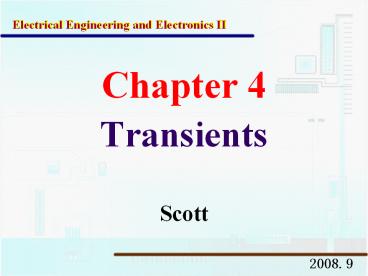Transients PowerPoint PPT Presentation
1 / 40
Title: Transients
1
Electrical Engineering and Electronics II
- Chapter 4
- Transients
Scott
2008.9
2
- Main Contents
1. Solve first-order RC or RL circuits. 2.
Understand the concepts of transient response and
steady-state response. 3. Relate the transient
response of first-order circuits to the time
constant. 4. Solve RLC circuits in dc
steady-state conditions.
3
- Main Contents
- Introduction
- Initial state and DC Steady State
- First-order RC Circuits
- First-order RL Circuits
- Summary
4
4.1 Introduction
When t8, uc(8)Us
transient
New steady state
When t0,uc(0)0
Old steady state
5
?
- Why the transient response happens?
Resistance circuit
- Resistor is a energy-consumption element, current
is proportional to voltage, no transient response
will happen even if changing source
6
- Energy can not change instantly because of
accumulating or decaying period.
7
- Energy can not change instantly because of
accumulating or decaying period.
8
- Transients
- The time-varying currents and voltages resulting
from the sudden application of sources, usually
due to switching.
- By writing circuit equations, we obtain
integrodifferential equations.
9
- The causes of transients
1. Energy storage elements
-inductors and capacitors
change gradually
2.Changing circuit, such as switching source.
10
4.2 Initial state and steady state
Assume changing circuit when t0, then t0
is end point of old steady state t0 is the
start point of transient state.
The law of changing circuit
From t0to t0,iL?uC change continuously.
11
DC Steady State Response
- The steps in determining the forced response or
steady state response for RLC circuits with dc
sources are - 1. Replace capacitances with open circuits.
- 2. Replace inductances with short circuits.
- 3. Solve the remaining circuit.
12
Example 4.1 Find steady-state values of vx and ix
in this circuit for tgtgt0.
Answer vx 5V, ix 1A tgtgt0
13
Exercise 4.3 Find steady-state values of labeled
currents and voltages for tgtgt0.
Answer va 50V, ia 2A
i1 2A, i21A, i31A
14
How to get initial value
- Exercise 1 Assuming old circuit is in DC steady
state before switch K is closed. how to get
uC(0),iR(0)?
Solution When t0-, capacitor is considered as
open circuit, we get equivalent circuit.
t0-
15
- How to get initial value
substituting voltage source for uC(0)
16
- How to get initial value
- Exercise 2 Given by R14O, R26O, R33O,
C0.1µF, L1mH, US36V, switch S is closed for a
long time. Open the switch S when t0, how to
get the initial values of all elements?
17
4.3 First-order RC Circuits
- First-order circuit
- Only one (equivalent) capacitor or
inductor is included in a linear circuit.
- Equivalent circuit of First-order circuit
- Two parts one (equivalent) capacitor
or inductor a two terminal network with
resistance and sources.
or
18
4.3 First-order RC Circuits
- According to Thevenin Law
or
19
- Differential equation of first-order RC circuit
20
First-order RC Circuits
- Example to find the transient response after
changing circuit when t0.
Solution
21
- First-order RC Circuits
22
- First-order RC Circuits
homogeneous solution
particular solution
23
- First-order RC Circuits
- homogeneous solution
24
- First-order RC Circuits
- Particular solution
Therefore
Then, the final solution is
25
- First-order RC Circuits
- The solution of differential equation
Substituting the initial condition
26
- First-order RC Circuits
- The solution of differential equation
Time constant
Steady state value
Initial value
27
- Three elements method
- Solution of other parameters
Three elements 1.steady state value f(8) 2.time
constant t 3. initial value f(0).
28
4.3 First-order RL Circuits
- Formula of Three element method
f(8)steady state value
f(0)initial value
ttime constant
tRC time constant of RC circuit
t ?? time constant of RL circuit
29
4.3 First-order RL Circuits
30
4.3 First-order RL Circuits
- Time constant
tRC
tL/R
31
- Time constant reflects the length of transient
period.
t ? 2? 3? 4? 5? 6? 7?
e-t/? 36.8 13.5 5 1.8 0.3 0.25 0.09
- After one time constants, the transient response
is equal to 36.8 percent of its initial value.
- After about five time constants, the transient
response is over.
32
- Time constant reflects the length of transient
period.
- The curves versus time
Mounting curve
The initial slop intersects the final value at
one time constant.
Decaying curve
33
- Three element method
- Steps
- Initial value t0-?t0 f(0)
- Steady state value t 8 f(8)
- Time constant tRC tL/R
- Substituting three elements
- Draw the curve versus time
- Limited Condition
1) first-order circuit 2) DC source
34
- Example 4.2 Find voltage of v(t) and current i(t)
in this circuit for tgt0.
Answer
35
(No Transcript)
36
- Example 4.3 Find voltage of v(t) and current i(t)
in this circuit for tgt0.
Answer
37
(No Transcript)
38
- Exercise 4.5 Find voltage of v(t) and current
iR(t) , iL(t) in this circuit for tgt0, assume
that iL(0)0.
Answer
39
- Exercise 4.5 Find voltage of v(t) and current
i(t), v(t) in this circuit for tgt0, assume that
the switch has been closed for a very long time
prior to t0.
Answer
40
- Homework 4
- P4.8
- P4.18
- P4.26
- P4.30

